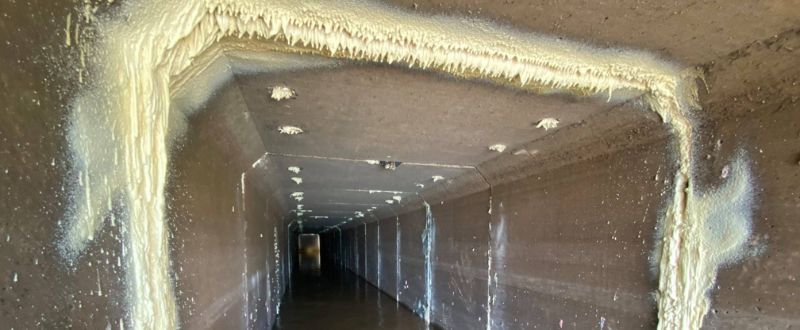Preventative maintenance extends the lifespan of infrastructure and buildings. Among the innovative solutions in this field, polyurethane injections stand out for their versatility and effectiveness. Discover how polyurethane injections are used for preventive maintenance in three key areas: stabilizing soil, sealing cracks, and waterproofing slabs.
Stabilizing Soil
Soil stabilization refers to the process of altering soil to improve its strength, durability, and overall bearing capacity. This process gives structures a stable and reliable foundation, preventing settlement and shifting that can lead to significant structural damage or failure. By enhancing the soil’s ability to support weight, soil stabilization plays a critical role in the longevity and safety of buildings, roads, and other infrastructures.
Polyurethane injections enhance the ground’s bearing capacity and fill subsurface voids to prevent settlement that can lead to structural damage. A trained crew member injects polyurethane into the soil. A chemical reaction causes the polyurethane to expand, filling voids and stabilizing the soil by binding it together. Polyurethaen injections are most effective when data from a geotechnical engineer is available. Boring and reports will inform the technicians at what depths to inject.
Sealing Small Cracks
Cracks in concrete slabs compromise the structural integrity of buildings and infrastructure by allowing moisture and harmful substances to penetrate. It’s not possible to completely prevent cracks from forming in concrete. Natural and environmental factors exert stress on the concrete, inevitably leading to cracks over time despite efforts to control them.
The following factors cause cracks to form on concrete:
- Shrinkage during curing: As concrete dries and hardens, it can shrink slightly, leading to the formation of cracks.
- Thermal expansion and contraction: Changes in temperature cause concrete to expand and contract, which can result in cracking if the material cannot accommodate these movements.
- Settling or shifting of the ground: Movement of the earth beneath a structure can create uneven support for the concrete, causing it to crack.
- Moisture changes: Variations in moisture content in the environment can lead to expansion and contraction of concrete.
- Excessive loads: Overloading concrete beyond its strength capacity can cause it to crack under pressure.
- Corrosion of embedded steel: As steel reinforcement within concrete corrodes, it expands, exerting internal pressure that can crack the concrete.
Foundation repair foam is an efficient solution for sealing these vulnerabilities. The injected polyurethane fills cracks, sealing against water infiltration and preventing further damage.
Preventing Water Infiltration
Water infiltration is a common issue for concrete slabs because rotted expansion joints, allowing water to seep through its surface and reach the internal structure. Water underneath concrete can erode soils freeze, contract, then thaw and expand, leading to cracking and spalling. Finally, water can carry harmful elements into the concrete that can chemically react with the slab and accelerate damage.
By creating a watertight seal, the foam prevents water from penetrating the material, protecting against erosion, mold growth, and structural weakening. And the water won’t degrade URETEK’s patented hydrophobic foam, which is one key to the foam’s long-term viability. Joints will still need to be caulked with a traditional sealant to prevent repeated water infiltration.
Polyurethane injections are a comprehensive preventive maintenance solution, addressing key issues that compromise the integrity and longevity of concrete structures. By stabilizing soil, sealing small cracks, and preventing water infiltration, this innovative method enhances the durability and safety of buildings and infrastructure.

